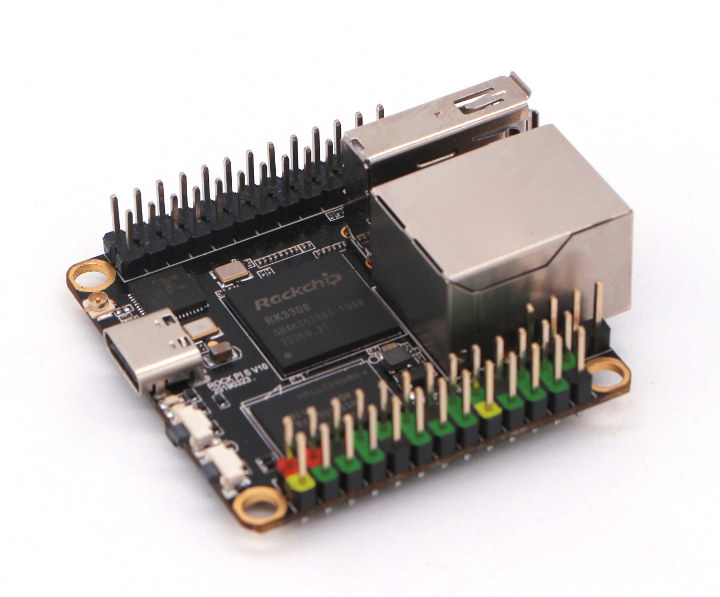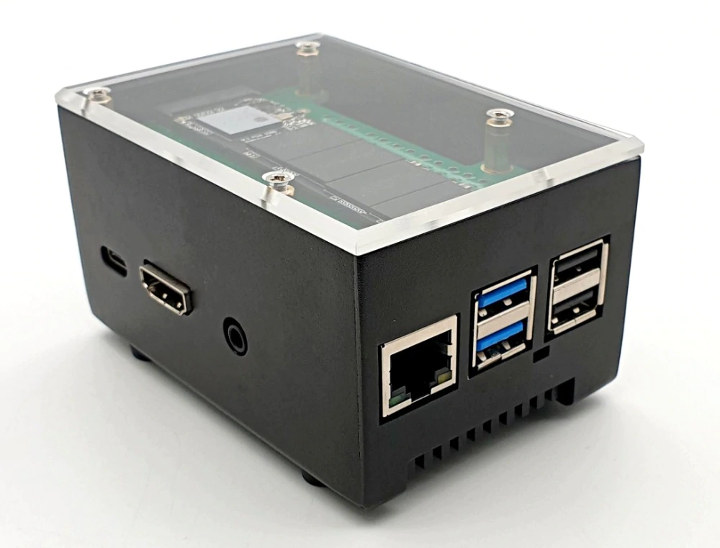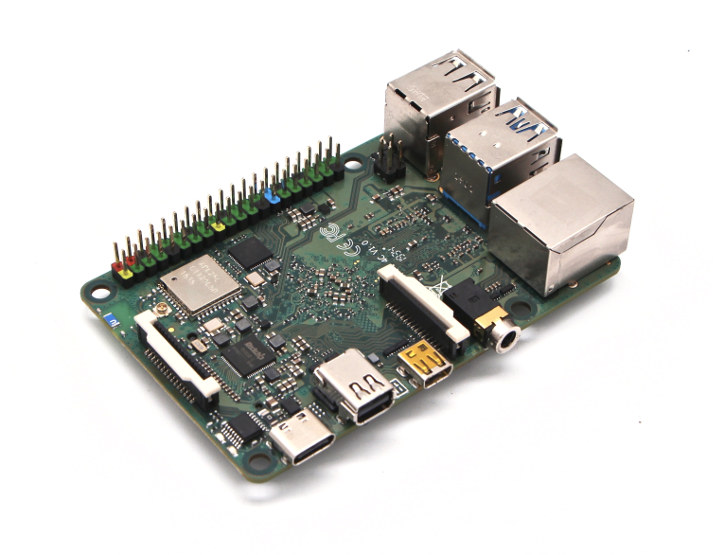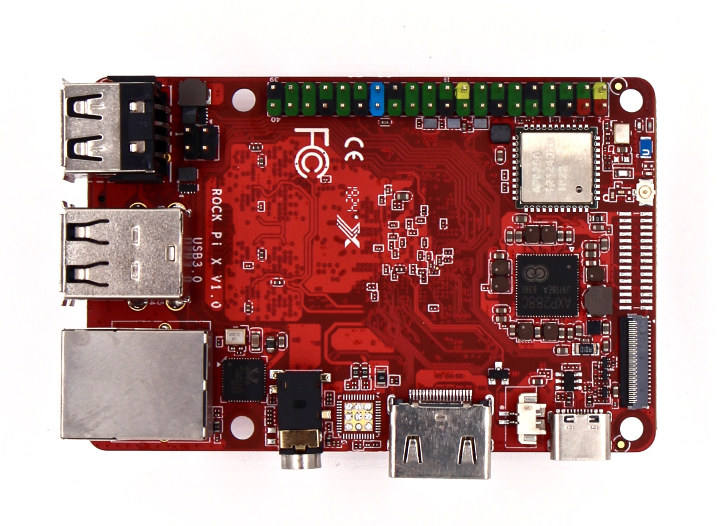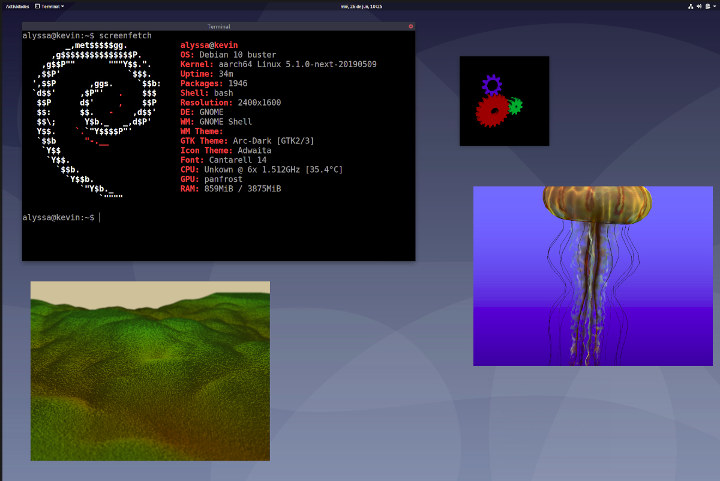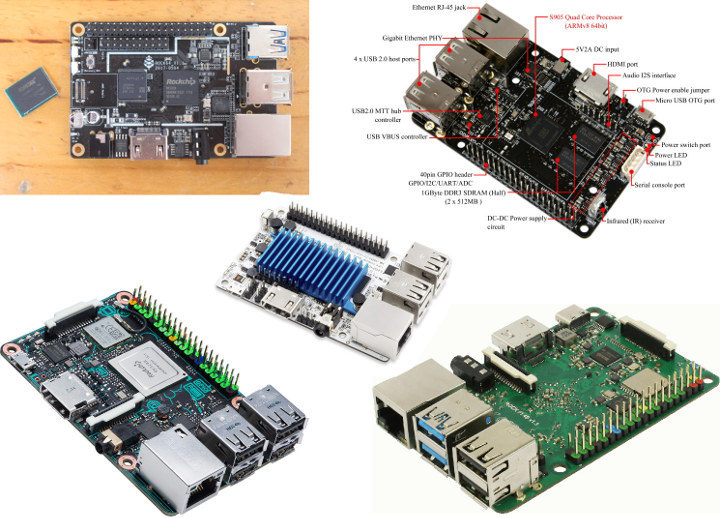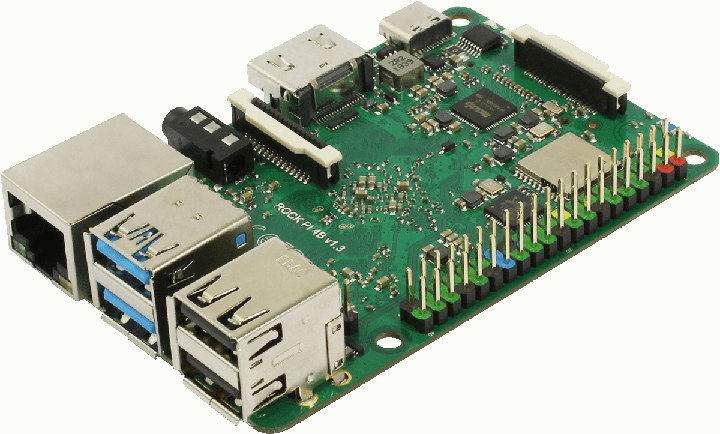Rock Pi S is a tiny single board computer powered by Rockchip RK3308 quad-core Cortex-A35 processor coupled with up to 512MB RAM, up to 1GB SD NAND flash, as well as a USB port, Fast Ethernet & optional WiFi & Bluetooth connectivity which was announced to sell for as low as $9.90 with 256MB RAM, 256MB flash and no wireless module. Seeed Studio has now started to take pre-orders for Rock Pi S with the board selling for $14.90 with 512 MB RAM, 512MB SD NAND flash, WiFi & Bluetooth. Shipping is scheduled to start on October 15th. [Update: Seeed Studio has also listed the 256MB RAM version of the board for $9.90] Rock Pi S specifications as currently sold on Seeed Studio: SoC – Rockchip RK3308 quad-core Arm Cortex-A35 processor @ up to 1.3 GHz with built-in VAD (Voice Activity Detector) System Memory – 512MB RAM Storage – MicroSD […]
ecoPI STARTER is a Cute Mini PC Kit Based on Rock Pi 4 SBC with Optional M.2 NVMe SSD
Rock Pi 4 is an affordable single board computer inspired by Raspberry Pi 3 Model B, but equipped with a more powerful Rockchip RK3399 hexa-core processor, and selling for around $80 with 4GB RAM, Gigabit Ethernet, and 802.11ac + Bluetotoh 5.0 wireless module. I’ve just come across ecoPI STARTER mini PC kit for the board with an aluminum case that can also fit an M.2 extension board to add an M.2 NVMe SSD card. The kit comes with an aluminum housing, an acrylic cover, some screws, bolts and silicon feet, and short ribbon cables for M.2 card. The acrylic cover is designed to let the WiFi & Bluetooth signal go through, but I’m not so confident the case won’t cause issue with WiFi. It’s currently sold for $16.50 on Aliexpress. You’ll also need to get Rock Pi 4A or 4B for $40 and up, M.2 Extension board ($8.39), heatsink ($8.39), […]
Rock Pi 4C SBC to Support Dual Display Setups via micro HDMI and mini DP Ports
Rockchip RK3399 powered Rock Pi 4 SBC was introduced at the end of 2018 and followed nearly exactly Raspberry Pi 3 Model B form factor just with a more powerful processor, GPU, as well as more memory depending on which model you purchase. But in June 2019, the Raspberry Pi foundation launched Raspberry Pi 4 SBC with a much faster processor and many of the same ports as its predecessor except for support for two HDMI displays via micro HDMI ports. Radxa has now followed suit with Rock Pi 4C which offers two modern video outputs, but with a twist as the upcoming SBC combines one micro HDMI port with one mini DP port. Rock Pi 4C was introduced at the XDC 2019 conference where open-source graphics developers meet, and Radxa was a “supporter”. The company explains Rock Pi 4B uses RK3399’s USB type-C controller for the two USB 3.0 […]
Rock Pi X Intel Cherry Trail Board to Sell for as low as $39
Most low cost (sub $100) single board computers are based on Arm processors because Intel processors are normally more expensive, but there are some exceptions with AAEON Up Board and Atomic Pi both powered by an Intel Atom x5-Z8350 processor and selling for $99 and $35 respectively. The former follows Raspberry Pi form factor and is easy to use, but the latter requires some more work to wire power supply unless you buy an extra baseboard. There should however soon be a third option for low-cost Intel SBCs with Radxa Rock Pi X board powered by an Intel Atom x5-Z8300 Cherry Trail processor and is expected to sell for as little as $39. Rock Pi X just showed up in Hackerboards database, and there will be two models, namely Rock Pi X model A and Rock Pi X model B with the following specifications: SoC – Intel Atom x5-Z8300 “Cherry […]
Rock Pi 4 SBC Runs GNOME & KDE Plasma using Panfrost Open Source GPU Driver & Wayland
One of the highlights of Linux 5.2 release was support for two new Arm Mali GPU open-source drivers, namely Lima for Mali-4xx GPU, and Panfrost for the Midgard Mali-T6xx/7xx/8xx series, and the more recent Bifrost Mali-Gxx GPUs. Collabora worked on the release and was donated a few Rock Pi 4 boards from Radxa directly to work on the project. For those who are not familiar, Rock Pi 4 board is powered by a Rockchip RK3399 processor with a Mali-T860MP4 GPU that is supported by Panfrost open source GPU driver. The company managed to have Debian 10 Buster running on Rock Pi 4 using 3D graphics acceleration thanks to Panfrost drivers on both GNOME and KDE Plasma desktop environment, as well as Weston Wayland compositer. The good news is that you can build Rock Pi 4 images by yourself using Debos with the following commands:
|
1 2 3 |
git clone https://gitlab.collabora.com/rockpi/rockpi4 cd rockpi4 docker run --rm --interactive --tty --device /dev/kvm --workdir /recipes --mount "type=bind,source=$(pwd),destination=/recipes" --security-opt label=disable godebos/debos --scratchsize=8G rockpi4.yml |
Alternatively, you could directly download […]
$9.9 ROCK Pi S is a Tiny SBC Powered by Rockchip RK3308 Processor
Radxa launched their low cost ($40) Rock Pi 4 SBC powered by Rockchip RK3399 processor a little over 18 months ago. If you are subscribed to their mailing list, the company has now sent an email entitled “ROCK Pi Summer Updates 2019” (no link available) that reports about v1.4 of the board with 4MB SPI flash onboard, an external WiFi antenna connector, and various other small changes, as well as the announcement of RockPi PoE HAT to power the board from an Ethernet cable, and an USB 3.0 eMMC card reader. But what particularly caught my attention in the email was a new tiny single board computer powered by Rockchip RK3308 Cortex-A35 processor: Rock Pi S selling for as low as $9.9 with 256MB RAM, and targetting headless IoT & smart voice applications. Rock Pi S board specifications: SoC – Rockchip RK3308 quad-core Arm Cortex-A35 processor with built-in VAD (Voice […]
Top 5 Raspberry Pi Alternatives in 2019
The Raspberry Pi boards are great little Arm Linux SBC’s with a low price and great community support. But the Broadcom processors used in the boards are also fairly old so they may not be suitable for some projects. If your application needs or would benefit from modern features such as memory over 1GB RAM, an actual Gigabit Ethernet port, USB 3.0 port(s), 4K video output, or H.265 hardware video decoding you’ll have to find Raspberry Pi alternatives. I’ll point out 5 alternative single board computers in this post from the point of view of existing Raspberry Pi users, who will want good software support and a board with the same or similar form factor as Raspberry Pi 3 Model B/B+ in order to reuse their add-on boards and/or enclosures. Price has to be competitive as well, so nothing above $80 will be mentioned. The boards are not listed in […]
Radxa Rock Pi 4 Review – Part 1: A First Look at RockPi 4B Performance Set
Hey, Karl here with another RK3399 board. This one is by Radxa and is called the Rock Pi 4. There are 2 main variants to this board and I was shipped the B version “performance set” which includes a power supply, heatsink, and acrylic case. Also shipped was 16gb eMMC 5.1 module, eMMC flashing board, and USB-TTL debug cable. It looks like the difference is the B version has AC wifi and GbE LAN with PoE support with a hat. The A version only has GbE. Rock Pi 4B Performance Set Unboxing Some of the more notable specs eMMC module support M.2 NVME SSD support (SATA not supported) HDMI 2.0 4k@60htz MIPI DSI 2 lanes via FPC connector 3.5mm audio jack MIPI CSI 2 lanes via FPC connector, support up to 8MP camera 802.11 ac wifi Bluetooth 5.0 40-pin expansion header : 1 x UART 2x SPI bus 2x I2C […]


